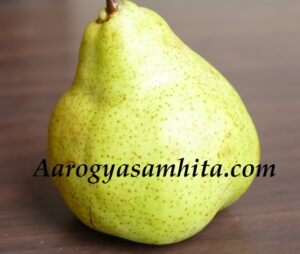Pears are one of the most popular fruits around the world, with their sweet flavor and crunchy texture. They are a great addition to any meal or snack, and are a healthy choice for those watching their weight. In this post, we’ll explore the many health benefits of pears, their nutritional content, and how to incorporate them into your diet. We’ll also discuss some fun pear recipes that you can make at home. Finally, we’ll provide some tips for selecting and storing pears to ensure that you get the most out of them. So let’s get started!

Pears Nutrition Facts and Calories Chart
This fruit is a great source of nutrition, providing essential vitamins and minerals to help support a healthy lifestyle. They are a good source of dietary fiber, containing 3.1 grams per medium pear. Pears are also a good source of vitamin C, containing 6.5 milligrams per medium pear. Additionally, pears are a good source of potassium, containing 181 milligrams per medium pear. Pears are low in calories and fat, making them a healthy and nutritious snack. Nutritional value per 100 g pears:
- Biotin: 0 mcg
- Calcium: 9 mg
- Carbohydrates (Carbs): 10.5 g
- Chloride: 2 mg
- Cholesterol: 0 mg
- Choline: 2.9 mg
- Chromium: 0.3 mcg
- Copper: 0.08 mg
- Dietary Fiber: 2.4 g
- Energy (Calories): 57 kcal
- Fat: 0.2 g
- Iodine: 0.6 mcg
- Iron: 0.2 mg
- Magnesium: 5 mg
- Manganese: 0.05 mg
- Molybdenum: 0.7 mcg
- Pantothenic Acid: 0.1 mg
- Phosphorus: 10 mg
- Potassium: 98 mg
- Protein: 0.3 g
- Saturated fat: 0.04 g
- Selenium: 0.1 mcg
- Sodium: 1 mg
- Sugars: 9.4 g
- Vitamin A: 32 IU
- Vitamin B1 (Thiamin): 0.02 mg
- Vitamin B2 (Riboflavin): 0.02 mg
- Vitamin B3 (Niacin): 0.1 mg
- Vitamin B5 (Pantothenic Acid): 0.1 mg
- Vitamin B6: 0.04 mg
- Vitamin B9 (Folate / Folic Acid): 3 mcg
- Vitamin B12: 0 mcg
- Vitamin C: 3.6 mg
- Vitamin D: 0 IU
- Vitamin E: 0.1 mg
- Vitamin K: 1.2 mcg
- Water: 85 g
- Zinc: 0.06 mg
Pears in India
Pear is a delicate, aristocratic, temperate zone fruit. America’s most widely grown pear, the Bartlett, is bell-shaped, with yellow skin and a red blush when ripe. It’s excellent for poaching, canning or eating raw in season, which is from July to mid-October. Prickly Pear is different that common pear.
- Scientific Binomial: Pyrus communis
- Common English: Common Pear / European Pear / Bhutan Pear
- Ayurvedic: Tanka
- Unani: Bagu-goshaa / Babbu-goshaa
- Sanskrit: Amritaphala
- Hindi / Urdu: Nashpati
- Bengali
- Marathi: Nashpati
- Telugu: Berikaya / Beripandu
- Tamil: Perikkay
- Gujarati
- Kannada
- Malayalam: Salvag / Saberjilli
- Oriya
- Punjabi / Sindhi
- Assamese
- Kashmiri
- Konkani
- Manipuri
- Dogri
- Bhojpuri
Home Remedies
Pears are rich source of sodium, iodine, fiber. 1 raw whole pear contains 4 g of fiber. Pears are useful in the treatment of acne, constipation, colitis, burns, skin problems, indigestion, weakness and jaundice.
- Skin Care: Pears are good for sunburn as well as to improve skin complexion. Here is a skin lotion recipe for burns and inflammation. Combine peach, pear and quince in a food blender with enough shaved ice to make a thick, cooling puree, which is then spread on some clean muslin and laid on the surface of the skin. But no matter how you use them, they’re great for a fantastic complexion.
- Constipation: There is nothing worse than not being able to “go” for a few days. If this is the case try drinking pear juice. Pears are also good sources of soluble fiber. In ordinary cases of constipation a medium-sized pear taken after dinner or with breakfast will have the desired effect.
- Oral Care: Eating a raw pear about an hour after meals helps to clean the teeth and heal the gums.
- Cold Sores: In case of genital herpes and cold sores, try pear juice, which is rich in anti-herpes caffeic acid, might be your best juice choice.
- Shingles: Pear fruit and juice is rich in antiviral caffeic and chlorogenic acids. Drink it and eat lots of pears for shingles. Caffeic acid is an immune stimulant, and researchers have found that chlorogenic acid has activity against HIV.
- Detox Drink: A morning cocktail consisting of pears is a great way to help flush out the system of all the old debris which may have accumulated during the night.
- In a food blender, combine 1 fresh, pitted peach half, 1 fresh pear half and 1 whole quince.
- Do not peel any of them, but wash thoroughly before liquefying.
- Add just enough broken ice cubes and a small amount of cold water to make a nice, refreshing beverage that’s smooth but not too thick.
- Digestive Aid: A very nice mucilage preparation can be made from pears and quinces as a soothing and strengthening tonic for delicate digestive systems, an aid for anemic conditions and speed recovery from serious illness or major surgery. Remove the inner cores from several ripe pears and quinces before cutting them up and inserting into a food blender with about 3 cups of carrot juice. Mix for several minutes on medium speed. Makes a delicious tonic drink when taken in the morning and evening in 8 oz. glass portions.
Side Effects and Precautions
The problem with soft fruit such as pears, is that pesticides saturate into the core of the fruit. This is why it should be washed and cleaned thoroughly to rinse off bacteria, as well as pesticides. It is recommended that wash it with dish detergent or special soaps that dissolve pesticides.
